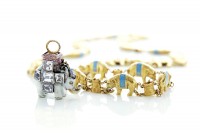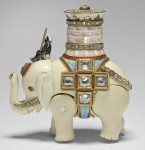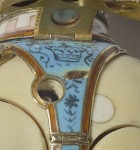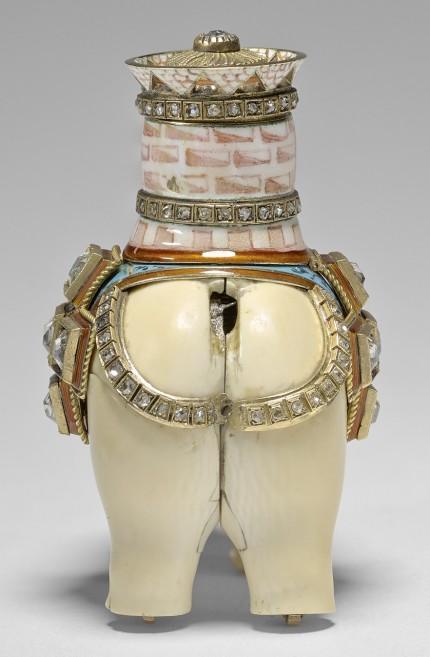 An imperial Fabergé egg will be reunited with its original surprise for the first time since the 1920s in a new exhibition at the Houston Museum of Natural Science (HMNS). Made of a translucent celadon stone and crisscrossed with a trellis pattern of rose-cut diamonds, the Diamond Trellis Egg is part of the McFerrin Fabergé Collection, the largest private collection of Fabergé treasures in the world, which is housed in the HMNS. The surprise inside, a jeweled ivory elephant wind-up automaton, was recently rediscovered in the Royal Collection and has been loaned to the museum by Queen Elizabeth II.
An imperial Fabergé egg will be reunited with its original surprise for the first time since the 1920s in a new exhibition at the Houston Museum of Natural Science (HMNS). Made of a translucent celadon stone and crisscrossed with a trellis pattern of rose-cut diamonds, the Diamond Trellis Egg is part of the McFerrin Fabergé Collection, the largest private collection of Fabergé treasures in the world, which is housed in the HMNS. The surprise inside, a jeweled ivory elephant wind-up automaton, was recently rediscovered in the Royal Collection and has been loaned to the museum by Queen Elizabeth II.
 Presented by Tsar Alexander III to his wife the Empress Maria Feodorovna (née Princess Dagmar of Denmark) for Easter in 1892, the Diamond Trellis Egg held an elephant surprise that was a virtually identical replica of the badge of the Order of the Elephant, Denmark’s highest chivalric order. The only differences are the materials — Fabergé used ivory instead of white enamel — and the automaton mechanism. It was the second egg Alexander commissioned for his wife to have a Danish theme. The first was the Danish Palaces Egg, presented to Maria Feodorovna on Easter, 1890. The surprise inside was a ten-panel folding screen with miniatures of the Tsarina’s favorite Danish and Russian palaces. After Alexander’s sudden death in 1894 at the age of 49, his son Tsar Nicholas II continued the tradition of Fabergé Easter eggs, gifting them to both his wife and to his mother. It was Nicholas who gave the Dowager Empress her third and last Danish egg, the Royal Danish Egg, now lost.
Presented by Tsar Alexander III to his wife the Empress Maria Feodorovna (née Princess Dagmar of Denmark) for Easter in 1892, the Diamond Trellis Egg held an elephant surprise that was a virtually identical replica of the badge of the Order of the Elephant, Denmark’s highest chivalric order. The only differences are the materials — Fabergé used ivory instead of white enamel — and the automaton mechanism. It was the second egg Alexander commissioned for his wife to have a Danish theme. The first was the Danish Palaces Egg, presented to Maria Feodorovna on Easter, 1890. The surprise inside was a ten-panel folding screen with miniatures of the Tsarina’s favorite Danish and Russian palaces. After Alexander’s sudden death in 1894 at the age of 49, his son Tsar Nicholas II continued the tradition of Fabergé Easter eggs, gifting them to both his wife and to his mother. It was Nicholas who gave the Dowager Empress her third and last Danish egg, the Royal Danish Egg, now lost.
 The Diamond Trellis Egg and its elephant were confiscated from the Anichkov Palace in St. Petersburg, Maria Feodorovna’s home base, by the Bolsheviks in 1917. It was sold in 1930 by the Antikvariat, the agency tasked with selling off Russia’s cultural patrimony to raise money for the Soviet government, probably to Emanuel Wartski, although there are no records of the sale.
The Diamond Trellis Egg and its elephant were confiscated from the Anichkov Palace in St. Petersburg, Maria Feodorovna’s home base, by the Bolsheviks in 1917. It was sold in 1930 by the Antikvariat, the agency tasked with selling off Russia’s cultural patrimony to raise money for the Soviet government, probably to Emanuel Wartski, although there are no records of the sale.
At some point in the saga the three parts of the egg, the base (now lost), the elephant and the egg got separated. In 1935 King George V bought the little elephant without knowing it was part of an Imperial Egg or even that it was made by Fabergé. It has been in the Royal Collection ever since, on display in one of the state rooms for decades.
 In 2015, Caroline de Guitaut, Senior Curator of the Royal Collection Trust, was cataloguing the collection when she noticed the elephant figurine bore a resemblance to the surprise in the Diamond Trellis Egg as described in Fabergé’s ledgers: “ivory figure of an elephant, clockwork, with a small gold tower, partly enamelled and decorated with rose-cut diamonds,” with “a black mahout…seated on its head.” The Trust’s restorers and clockmakers painstakingly took the elephant apart down to the internal mechanism. They finally found the confirmation of the figurine’s origin under the top part of the castle on the elephant’s back. There was the unmistakable hallmark of Carl Fabergé.
In 2015, Caroline de Guitaut, Senior Curator of the Royal Collection Trust, was cataloguing the collection when she noticed the elephant figurine bore a resemblance to the surprise in the Diamond Trellis Egg as described in Fabergé’s ledgers: “ivory figure of an elephant, clockwork, with a small gold tower, partly enamelled and decorated with rose-cut diamonds,” with “a black mahout…seated on its head.” The Trust’s restorers and clockmakers painstakingly took the elephant apart down to the internal mechanism. They finally found the confirmation of the figurine’s origin under the top part of the castle on the elephant’s back. There was the unmistakable hallmark of Carl Fabergé.
 When the cleaned and restored elephant was put back together, curators were ecstatic to find that the mechanism still worked. They slid the key into the hole hidden under the diamond cross on the elephant’s side, wound it up, and the little guy walked and nodded his head like he’d never lived through war, revolution and separation from his home egg.
When the cleaned and restored elephant was put back together, curators were ecstatic to find that the mechanism still worked. They slid the key into the hole hidden under the diamond cross on the elephant’s side, wound it up, and the little guy walked and nodded his head like he’d never lived through war, revolution and separation from his home egg.
The reunited egg and elephant will help inaugurate the Houston Museum of Natural Science’s new gallery dedicated to the Artie and Dorothy McFerrin Collection and its whopping 600 pieces of Fabergé. Fabergé: Royal Gifts featuring the Trellis Egg Surprise opens April 10th. The elephant will be on loan for a year before returning to the Royal Collection.
There are some beautiful views of the glittering egg and surprise in this brief video in which Caroline de Guitaut and Joel Bartsch, President of the Houston Museum of Natural Science, discuss the discovery of the missing piece. There’s an all too brief glimpse of the elephant’s movement at the 1:57 mark.
This video from the Royal Collection Trust, on the other hand, shows nothing but the automaton’s motion, starting with the wind-up. He raises his head every few steps. It’s absurdly cute.
Oh hey, guess what?

‘ELEPHANT BUTT!’ I know several who see that identical view each time they look over their shoulder and into a mirror. Sigh….
Never got a “surprise” from a Cracker Jacks box that pooped diamonds.
Great way to get little kids interested in history! Promise them a joke from their lexicon.
@Audrey: Your friends need to make sure that -under all circumstances- enough diamonds are adorning ‘theirs‘, and it all will be fine :yes:
Also, it may help to avoid unhelpful intake and to get moving around on fast bicycles (in the latter case -temporarily- w/o the diamonds).
Yup! My favorite Blog!
I always appreciate thehistoryblog.com for his informative and unique posts and article. It’s one of my favorite blogs and I am always encouraged peoples to read this blog.
As always……….today’s story is too unique and great.Glad to read this post. Thanks for sharing this and make us part of this.
Even if the subject seems like something I’m not interested in, by the time I finish reading it, I’m hooked, and I’ve learned something. Thank you.
This is a great story. The elephant video is so cute.
The happy ending to this story would be if the egg and elephant stayed together.
“Elephant Butt?!?”
Shocking and shameful, Livius. The poor beast lost it’s tail and you call it “Elephant Butt”? Tsk, tsk, tsk….
You better hope your Mom doesn’t see this. Boy, are you going to get it! Now where did I put her number?
Great story. Poor elephant. Maybe someone will find his tail in some other collection. Wonder what it looked like?
I love your every post, and Elephant Butt deserves special notice.
I feel sad 🙁 A real elephant had to be killed in order to make a mechanical toy to entertain a person. This just does not sound right. No matter how small it is and who made it, this ivory elephant lost its values for me because it left a big impact on nature. A real elephant lost its life, Earth was dug up for precious metals and diamonds. This was just too much. I wonder if anybody think about how much such things like this elephant cost to our planet?
Behold, the Elephant-In-The-Room!
I NEED that elephant!!!! He’s soooooooo cute. The cutest little moving elephant I’ve ever seen!!! I think the smallest wind-up I’ve ever seen period. I’m in love.
That egg ain’t 1/2 bad either :notworthy:
The earth was dug up to grow the food that keeps you alive. As for the metals and plastics in your computer you posted with, well, you probably wouldn’t want to know what they cost. Myself I wouldn’t be surprised if this was made with ivory from a Siberian mammoth, since that would be suitably Russian. Think of the holocaust Mother Nature created which wiped out those millions of large animals in one fell swoop! Surely we ought to indict her before the bar of history; don’t you think?
I’m surprised the “stone-work” effect on the tower is so crudely drawn on, rather than being cut. When you see the work done with the engine turning machines such as Holtzappfel lathes, something much more striking could have been created. I wonder if they were running out of time to finish?